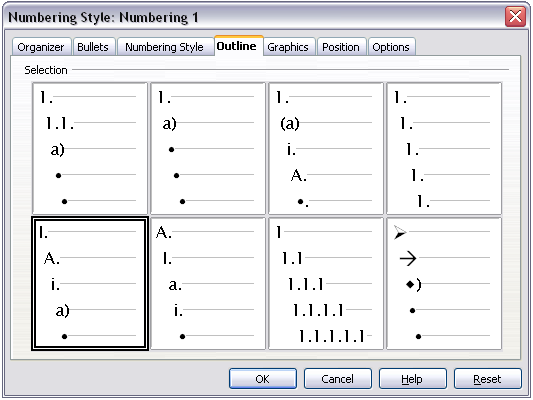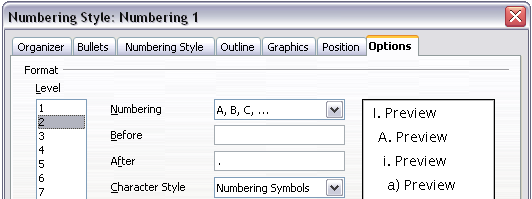Difference between revisions of "Documentation/OOoAuthors User Manual/Writer Guide/Working with list (numbering) styles"
| Line 1: | Line 1: | ||
| + | {{DISPLAYTITLE:Working with list (numbering) styles}} | ||
{{WriterStylesTOC|PrevNext=block | {{WriterStylesTOC|PrevNext=block | ||
|Prev=Documentation/OOoAuthors User Manual/Writer Guide/Defining a hierarchy of headings | |Prev=Documentation/OOoAuthors User Manual/Writer Guide/Defining a hierarchy of headings | ||
|Next=Documentation/OOoAuthors_User_Manual/Writer Guide/Working with conditional paragraph styles}}__notoc__ | |Next=Documentation/OOoAuthors_User_Manual/Writer Guide/Working with conditional paragraph styles}}__notoc__ | ||
| − | |||
Use a numbering (list) style to define the appearance of a list, whether a simple list or an ''outline'' or ''nested list'' (sometimes called ''multi-level numbering''). An example of setting up a simple list is given in Chapter 6. This section describes how to define a nested list. | Use a numbering (list) style to define the appearance of a list, whether a simple list or an ''outline'' or ''nested list'' (sometimes called ''multi-level numbering''). An example of setting up a simple list is given in Chapter 6. This section describes how to define a nested list. | ||
| Line 71: | Line 71: | ||
To insert a tab stop at the beginning of a numbered paragraph (that is, after the number but before the text), press ''Control+Tab''.}} | To insert a tab stop at the beginning of a numbered paragraph (that is, after the number but before the text), press ''Control+Tab''.}} | ||
| − | {{ | + | {{CCBY}} |
| + | [[Category: Writer Guide (Documentation)]] | ||
Revision as of 02:52, 21 March 2008
- Applying styles
- Modifying styles
- Creating new (custom) styles
- Copying and moving styles
- Deleting styles
- Working with paragraph styles
- Outline numbering
- Defining a hierarchy of headings
- Working with list (numbering) styles
- Working with conditional paragraph styles
- Working with frame styles
- Working with page styles
| [[{{{PrevPage}}}|< Previous Page
]] |
[[{{{NextPage}}}|Next Page
>]] |
Use a numbering (list) style to define the appearance of a list, whether a simple list or an outline or nested list (sometimes called multi-level numbering). An example of setting up a simple list is given in Chapter 6. This section describes how to define a nested list.
Defining the appearance of a nested list
A nested list is a numbered or bulleted list with subordinate (usually indented) numbered or bulleted lists. Rather than just a list of numbered items (1,2,3...), a nested list may have item 1, then indented items numbered a,b,c or i,ii,iii or some other numbering method before the main number 2. With numbering styles you can achieve any combination of numbering formats you want.
As an example, we will use outline-numbering to produce the following effect:
- I. Level-1 list item
- A. Level-2 list item
- i. Level-3 list item
- a) Level-4 list item
You can modify a predefined style, or define a new style. This example uses one of the supplied styles, Numbering 1.
- In the Styles and Formatting window, choose Numbering Styles and select a style such as Numbering 1. Right-click on the style and select Modify.
- On the Numbering Style dialog box, go to the Outline page, where you will find that one style matches our requirements. Click once on that style.
- To modify the layout of the list, use the Options tab. Notice that the preview on the right shows the outline selected. In the Level box on the left, select 1, then 2, 3, and 4 and see how the information in the Numbering and After boxes changes. Use the Options page to set different punctuation; for example, a period (full stop) after “a" on level 4 instead of a parenthesis.
- To make the indentation at each level greater or less than the default, change it on the Position page. Select the heading level, then make any changes in the indentation, spacing, or numbering alignment.
- Repeat for each heading level as required, then click OK to save the style.

Choosing a predefined outline-numbering style.

Checking the outline numbering for level-1 list items.

Numbering style for level-2 list items.
Applying the different levels of a list-numbered paragraph style
To apply the different levels of a list-numbered paragraph style:
- Type the first paragraph and apply the List 1 style. Notice that the level-1 list number is added automatically.
- Select View > Toolbars > Bullets and Numbering to display the Bullets and Numbering toolbar.
- Press Enter to start the next paragraph. To make it a level-2 list item, click the Demote one level icon on the object bar. The number applied to this paragraph has changed to a level-2 number.
- Continue typing list items, moving each paragraph up or down levels as needed.
| 1 Bullets On/Off | 8 Insert Unnumbered Entry | |
| 2 Numbering On/Off | 9 Move Up | |
| 3 Numbering Off | 10 Move Down | |
| 4 Up One Level | 11 Move Up with Subpoints | |
| 5 Down One Level | 12 Move Down with Subpoints | |
| 6 Move Up (One Level) with Subpoints | 13 Restart Numbering | |
| 7 Move Down (One Level) with Subpoints | 14 Bullets and Numbering |
Bullets and Numbering toolbar
| Content on this page is licensed under the Creative Common Attribution 3.0 license (CC-BY). |
